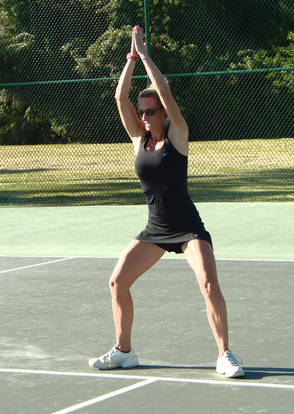Apart from the traditional, misinformed belief that pre-exercise stretching improves performance, a second major reason many coaches and athletes still perform static stretching before activity is to aid in the prevention of injury. The thought that pre-activity static stretching may reduce injury is typically linked to the theory that a “tight” muscle-tendon unit is less compliant, which means that it cannot be stretched to as great a degree. However, current research does not support this assumption and fails to show that pre-activity static stretching reduces the risk of injury.
|
Traditional recommendations for warming up before a tennis match have included stretching the major muscles involved in tennis movement. However, research on similar sports to tennis shows dynamic stretching (stretching while moving) yields the greatest benefits during the warm-up to a match. Despite early evidence as far back as the 1960s that static stretching prior to activity did not improve performance, it has been common practice by most coaches and tennis players in warm-up routines. Contrary to the typical anecdotal belief that static stretching helps improve physical performance, there is only a small amount of evidence suggesting it enhances athletic performance. Numerous studies, however, demonstrate that traditional “static” stretching actually impairs performance in strength, speed and power activities. Depth jump performance (a good indication of power output) as well as vertical jump height were significantly reduced. This deficit in performance can last approximately 60 minutes after the stretching routine.
Apart from the traditional, misinformed belief that pre-exercise stretching improves performance, a second major reason many coaches and athletes still perform static stretching before activity is to aid in the prevention of injury. The thought that pre-activity static stretching may reduce injury is typically linked to the theory that a “tight” muscle-tendon unit is less compliant, which means that it cannot be stretched to as great a degree. However, current research does not support this assumption and fails to show that pre-activity static stretching reduces the risk of injury.
2 Comments
5/20/2012 09:22:52 am
It very hot weather, I would question why ANY warm-up beyond courtesy hitting with your opponent would be in any way beneficial and instead would contribute to HIGHER body temp in warm to hot weather. A few serves, a few strokes to get your mind and coordination in sync, and stop there.
Reply
Phillip, you make a valid point that if the purpose of the warm-up is just to raise core temperature to perform the tennis session, then any type of activity where the athlete will be sweating would do the trick. However, the dynamic warm-up also adds a number of other benefits during the time period including: strength, stability, coordination, flexibility all while getting the mind ready for the competition or training session. This is always a great discussion point and interested to hear other views on this topic.
Reply
Your comment will be posted after it is approved.
Leave a Reply. |
iTPA Blog
The leader in tennis fitness, performance, education and tennis certification. Get iTPA Certified today! Categories
All
|





 RSS Feed
RSS Feed
